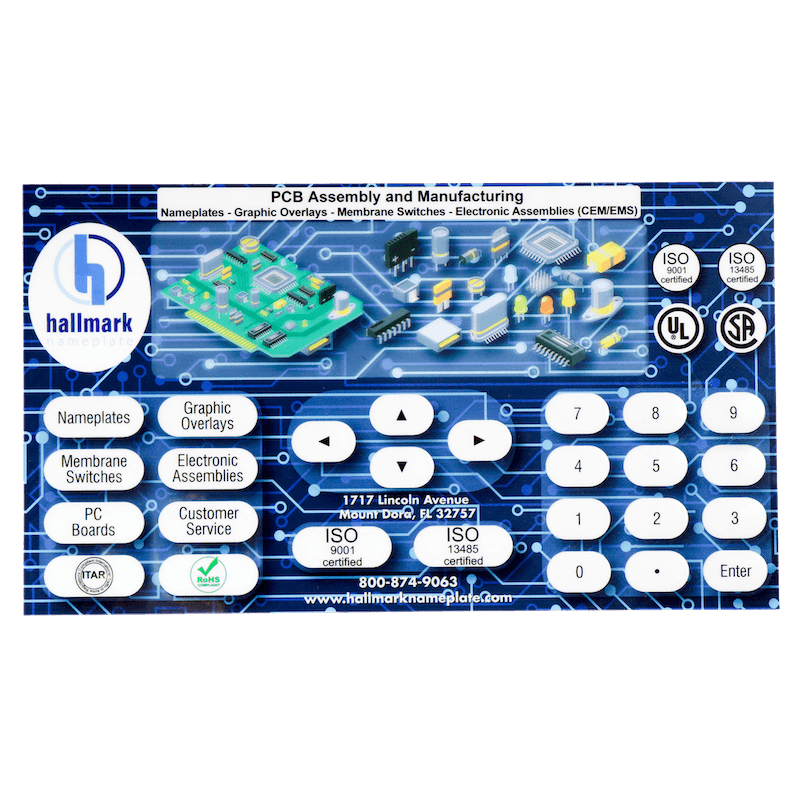Understanding Membrane Switches Over: The Key to Durable and Trusted Controls

What Are Membrane Switches?
Membrane buttons are an innovative solution in the world of interface innovation, incorporating capability and design perfectly. These gadgets offer as a user interface in between customers and digital systems, integrating several components into a small style. Commonly created from adaptable, slim layers of materials, membrane layer buttons are designed to respond to touch, enabling customers to engage with equipment and digital gadgets successfully.
The main aspects of a membrane switch include a printed circuit layer, visuals overlay, and a spacer layer that protects against unplanned activation. The visuals overlay can be customized to reflect brand identity or user preferences, improving visual appeals while ensuring usability. Membrane switches are generally used in numerous applications, consisting of medical devices, customer electronic devices, and industrial tools, owing to their durability and resistance to ecological aspects such as dampness and dirt.
One of the key advantages of membrane layer buttons is their ability to hold up against deterioration, making them ideal for high-traffic settings. Additionally, they are lightweight and need minimal room, allowing for ingenious designs in product growth. Generally, membrane layer changes stand for a useful and reliable option for contemporary electronic interfaces, weding modern technology with user-centric style principles.
How Membrane Switches Over Work
The procedure of membrane switches depend upon an easy yet efficient device that converts customer input right into electronic signals. These switches contain numerous layers, usually including a graphic overlay, a spacer layer, and a circuit layer. When a customer presses the button, the leading layer flaws, enabling a conductive element in the circuit layer to reach a corresponding conductive pad on the underside of the graphic overlay. This call closes the circuit and sends out an electronic signal to the tool, indicating that the button has actually been turned on.
The style of membrane layer buttons can differ, yet they often integrate domes or tactile elements to provide responses to the user, improving the general experience - membrane switch. The products used in membrane layer switches, such as polyester or polycarbonate, add to their resilience and resistance to ecological factors, consisting of moisture and dust. The printed circuits are normally enveloped, which protects them from wear and tear over time.
Advantages of Membrane Layer Buttons

Additionally, membrane layer buttons are recognized for their resilience. Created from robust materials, they are immune to dust, this contact form dampness, and physical wear, which substantially expands their life-span compared to traditional mechanical switches. This resilience makes them specifically appropriate for high-traffic settings and applications requiring longevity.
One more substantial advantage is the simplicity of cleaning and maintenance. The smooth surface of membrane switches lessens dust buildup and is typically unsusceptible spills, making them perfect for setups that need constant sanitization.
In addition, membrane buttons supply a structured profile, causing a thinner layout that can be incorporated right into various tools without adding bulk. This function not just enhances the aesthetic appeal yet likewise adds to a more ergonomic item design.
Applications of Membrane Switches
User-friendly and functional, membrane layer buttons discover applications throughout a variety of markets, including medical devices, consumer electronic devices, and industrial devices. In the clinical area, these buttons are essential to devices such as analysis devices, patient surveillance systems, and mixture pumps, where reliability and convenience of cleaning are important. Their capacity to endure harsh atmospheres and maintain performance makes them perfect for such applications.

In customer electronic devices, membrane buttons are used in products like microwaves, cleaning makers, and remote controls - membrane switch. Their streamlined design permits for intuitive user interfaces, enhancing the total user experience while providing toughness and resistance to damage
Commercial devices likewise profits from membrane switches, particularly in control panels for equipment and automation systems. These buttons offer defense against dirt and dampness, guaranteeing consistent performance in challenging environments. Moreover, their adjustable functions permit manufacturers to tailor them to particular operational needs, improving efficiency and performance.
Choosing the Right Membrane Switch
When picking a membrane layer button, it is important to consider different factors that affect performance and suitability for particular applications. The main considerations include ecological problems, tactile comments, sturdiness, and layout requirements.
First, examine the operating atmosphere; buttons subjected to moisture, chemicals, or extreme temperature levels need specific materials to make sure long life and functionality. Next, evaluate the demand for tactile comments. Depending upon customer interaction, some applications might take advantage of a tactile feedback to verify activation, while others might like a non-tactile layout for aesthetic reasons.
Sturdiness is an additional important aspect; membrane layer buttons must be designed to stand up to visit our website constant use, impacts, and abrasion. Ensure the chosen switch can endure the anticipated lifecycle, especially in high-usage situations.

Conclusion
In conclusion, membrane switches offer as crucial components in the design of long lasting and reliable control systems across numerous markets. The convenience of membrane changes permits for customized solutions that fulfill details functional needs, reinforcing their importance in contemporary technology.
Membrane layer switches over stand for a vital facet of contemporary user interface style, mixing capability with strength in different applications.Membrane layer buttons are an advanced remedy in the realm of individual interface innovation, integrating capability and layout seamlessly. Usually built from versatile, thin layers of materials, membrane switches are developed to react to touch, published here allowing users to interact with machinery and electronic gadgets efficiently.
The style of membrane switches can vary, yet they usually incorporate domes or responsive components to supply responses to the individual, improving the overall experience.In verdict, membrane layer switches over serve as vital elements in the style of durable and trustworthy control systems throughout different markets.
Comments on “Top Features to Look for in a High-Quality Membrane Switch”